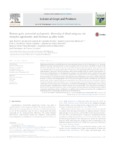Por favor, use este identificador para citar o enlazar este ítem:
http://www.alice.cnptia.embrapa.br/alice/handle/doc/1072202Registro completo de metadatos
| Campo DC | Valor | Lengua/Idioma |
|---|---|---|
| dc.contributor.author | ROCHA, J. R. do A. S. de C. | pt_BR |
| dc.contributor.author | MACHADO, J. C. | pt_BR |
| dc.contributor.author | CARNEIRO, P. C. S. | pt_BR |
| dc.contributor.author | CARNEIRO, J. da C. | pt_BR |
| dc.contributor.author | RESENDE, M. D. V. de | pt_BR |
| dc.contributor.author | LEDO, F. J. da S. | pt_BR |
| dc.contributor.author | CARNEIRO, J. E. DE S. | pt_BR |
| dc.date.accessioned | 2017-07-07T11:11:11Z | pt_BR |
| dc.date.available | 2017-07-07T11:11:11Z | pt_BR |
| dc.date.created | 2017-07-07 | pt_BR |
| dc.date.issued | 2017 | pt_BR |
| dc.identifier.citation | Industrial Crops and Products v. 95, p. 485-492, 2017. | pt_BR |
| dc.identifier.uri | http://www.alice.cnptia.embrapa.br/alice/handle/doc/1072202 | pt_BR |
| dc.description | Elephantgrass has been a notable option as bioenergy plant. However, for its bioenergetic use, the quantification of genetic diversity based on biomass quality traits has not been commonly reported in the literature. The objective of this study was to quantify the genetic diversity among 100 accessions of the Active Elephantgrass Germplasm Bank (BAGCE), by means of morphological (flowering, height, vigor and stalk diameter), agronomic (total dry biomass) and biomass quality traits (dry matter concentration, cellulose, lignin, hemicellulose, in vitro digestibility, nitrogen, ash, and calorific value), and the ultimate goal was to use the elephantgrass as a bioenergy feedstock. By using mixed model methodology and genetic diversity analyses, it was found genetic variability between elephantgrass accessions, which is the basic premise to start any breeding program. The BAGCE presented greater genetic variability for the biomass quality traits, when compared with morpho-agronomic traits. The accessions were divided into 6 clusters of genetic similarity, with potential for use in second generation ethanol production and direct biomass combustion, besides forage uses. Furthermore, to potentiate elephantgrass as bioenergetic plant, crosses among divergent individuals from distinct clusters were recommended. Thus, the genetic variability of BAGCE can be exploited to produce superior combinations that can maximize second generation ethanol conversion and biomass direct combustion. In addition, these actions can increase the contribution of elephantgrass for a sustainable energetic matrix diversification | pt_BR |
| dc.language.iso | eng | eng |
| dc.rights | openAccess | eng |
| dc.subject | Mixed models | pt_BR |
| dc.title | Bioenergetic potential and genetic diversity of elephantgrass via morpho-agronomic and biomass quality traits. | pt_BR |
| dc.type | Artigo de periódico | pt_BR |
| dc.date.updated | 2017-07-07T11:11:11Z | pt_BR |
| dc.subject.thesagro | Pennisetum Purpureum | pt_BR |
| dc.subject.nalthesaurus | ethanol | pt_BR |
| dc.subject.nalthesaurus | bioenergy | pt_BR |
| dc.subject.nalthesaurus | combustion | pt_BR |
| riaa.ainfo.id | 1072202 | pt_BR |
| riaa.ainfo.lastupdate | 2017-07-07 | pt_BR |
| dc.contributor.institution | JOÃO ROMERO DO AMARAL SANTOS DE CARVALHO ROCHA, UFV/VIÇOSA; JUAREZ CAMPOLINA MACHADO, CNPGL; Pedro Crescêncio de Souza Carneiro, UFV/VIÇOSA; JAILTON DA COSTA CARNEIRO, CNPGL; MARCOS DEON VILELA DE RESENDE, CNPF; FRANCISCO JOSE DA SILVA LEDO, CNPGL; José Eustáquio de Souza Carneiro, UFV/VIÇOSA. | pt_BR |
| Aparece en las colecciones: | Artigo em periódico indexado (CNPGL)  | |
Ficheros en este ítem:
| Fichero | Descripción | Tamaño | Formato | |
|---|---|---|---|---|
| Cnpgl2017IndCropsProdRochaBioenergetic.pdf | 1,87 MB | Adobe PDF |  Visualizar/Abrir |









